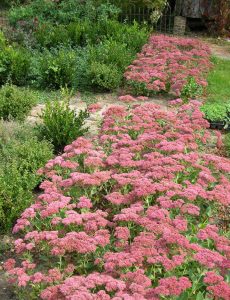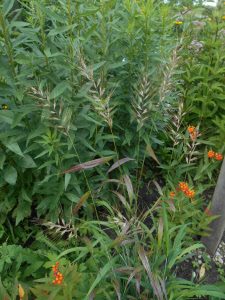Our Plants
Showing 313–320 of 587 results
-
Hylotelephium herbstsfreude syn Sedum ‘Autumn Joy’ Z 4-9
Classic, large flat flower heads turn from green to rose
Classic, large flat flower heads turn from green to rose blooming in September and October. A staple for autumn in the garden.
Size: 30” x 12”
Care: full sun in well-drained soil
Wildlife Value: Attracts many bees and butterflies. Black walnut tolerant, deer resistant.
Awards: England’s Royal Horticultural Society Award of Garden Merit.Autumn Joy introduced to gardens before 1920 by the George Arends Nursery in Ronsdorf, Germany.
-
Hylotelephium sieboldii syn Sedum sieboldii, October Daphne Z 3-9
Fleshy gray-green foliage edged with pink encircles the prostrate stems, flowering strawberry pink in fall. Perfect for rock gardens, front of border, fairy gardens, roof gardens, troughs and groundcover or anyplace with drought.
Fleshy gray-green foliage edged with pink encircles the prostrate stems, flowering strawberry pink in fall. Perfect for rock gardens, front of border, fairy gardens, roof gardens, troughs and groundcover or anyplace with drought.
Size: 4" x 8"
Care: full sun in moderately fertile, well-drained soil.
Native: Japan
Wildlife Value: Drought tolerant and deer resistant.
Awards: Elisabeth Carey Miller Botanical Garden Great Plant PickSedum means “plant that sits.” “Live forever” is an ancient Greek name for sedums. The Roman Pliny claimed that sedum’s juice treated wounds. In the 1500’s English herbalist Gerard called sedums “very full of life,” referring to succulent’s quality of being very easy to grow. This species named for its discoverer, Dr. Philipp Franz von Siebold (1791-1866). Von Siebold, a German doctor, worked for the Dutch East India Company as its resident physician on Deshima Island, off the coast of Japan. He boldly became too knowledgeable about Japanese affairs and was imprisoned by the Japanese in 1826 and then banished in 1828. When he left he carried nearly 500 plants with him to Europe. William Robinson, father of the mixed perennial border, described Sedum sieboldii as beautiful. He advised gardeners to grow it “in strong loam and mortar rubble in fully exposed positions (and use it as) an excellent plant for vases in summer.”
-
Hypericum kalmianum Kalm’s St. Johns wort SHRUB Z 4-7
Eye-catching yellow saucers with a puff of showy prominent stamens in mid to late summer complimenting the glaucous blue leaves on this mounding, easy- to-grow, shrub.
Eye-catching yellow saucers with a puff of showy prominent stamens in mid to late summer complimenting the glaucous blue leaves on this mounding, easy- to-grow, shrub.
Size: 3-4’ x 3-4’
Care: sun to shade in well-drained to moist well-drained soil. Blooms on new growth so prune in late winter to early spring as far back as you wish.
Native: Quebec to WI, S. to IL, Wisconsin native.
Wildlife Value: attracts bees and butterflies
Awards: Great Plants for Great PlainsThe name Hypericum comes from Greek hyper, meaning above, and eikon, meaning icon or image. The yellow flowers of some species were placed above images to ward off evil spirits, and according to legend, Satan pierced the leaves in revenge. This species collected by and named for Peter Kalm (1716-1779), Swedish plant hunter, on his expedition in North America, 1747-1751. Offered for sale in Bartram Garden’s 1783 Broadside, America’s 1st plant catalog. David Douglas (Douglas fir guy) also collected this at Niagara Falls per British botanist William Jackson Hooker (1785-1865).
**LISTED AS OUT OF STOCK BECAUSE WE DO NOT SHIP THIS ITEM. IT IS AVAILABLE FOR PURCHASE AT OUR RETAIL LOCATION.
-
Hystrix patula syn. Elymus hystris var. hystris Bottle brush grass Z 5-9
June thru fall bears 6” long spikes looking like bottle brushes
OUT OF STOCK
June thru fall bears 6” long spikes looking like bottle brushes.
Size: 2-3’ x 12-18”
Care: sun to part shade in dry to moist well-drained soil - tolerates dry shade
Native: Nova Scotia S to Virginia, W to ND and OK. Wisconsin native
Wildlife Value: Birds eat seedsHystrix from the Greek (‘hedgehog’) meaning “with spikes” or “bristly” describing the flowers and patula means “spreading.” Collected before 1794. In 1913 L H Bailey wrote, “sometimes used for lawn decoration and for borders.”
-
Iberis sempervirens Candytuft Z 5-9
Profuse clusters of small, pure white flowers, each flower made of multiple small petals blooming in April and May on this evergreen subshrub.
Profuse clusters of small, pure white flowers, each flower made of multiple small petals blooming in April and May on this evergreen subshrub.
Size: 6-12” x 24”
Care: Sun in moist well-drained soil
Native: Southern Europe
Wildlife Value: nectar source for gray hairstreak butterfly
Awards: England's Royal Horticultural Society Award of Garden Merit.Iberis is Latin for Spain, “Iberia” the country where the plant was first discovered. The common name “Candytuft” comes from Candia, Crete where the plant grew. In 1623 English herbalist, John Parkinson (1567-1650) included the Candytuft in his Garden of Pleasant Flowers saying it: “is not so sharpe biting in taste…and therefore is not to be used in medicines.”
-
Ilex verticillata Winterberry holly Z 3-9 FEMALE
White flowers in May turning to dense clusters of lurid red berries lasting from fall into winter on female plants. One male needed to fertilize 3 or 4 4 female plants. Female plants have a plump round ovary at the center and vestigial stamens – sticks up; male flowers have a greatly reduced and lower center-and prominent stamens with ample pollen.
White flowers in May turning to dense clusters of lurid red berries lasting from fall into winter on female plants. One male needed to fertilize 3 or 4 4 female plants. Female plants have a plump round ovary at the center and vestigial stamens – sticks up; male flowers have a greatly reduced and lower center-and prominent stamens with ample pollen.
Size: 6-16’ x 6-10’
Care: sun to part shade in moist to moist well-drained, acidic soil
Native: Canada to FL, West to WI and MO. Wisconsin native
Wildlife Value: Berries are important winter food for Robin, Bluejay, Catbird, Cedar waxwing, Chickadee, Finch, Flicker, Mockingbird, Mourning dove, Nuthatch, Sparrow, Tanager, Thrasher, Towhee, Warbler, Woodpecker.Natives Americans used bark to induce vomiting, to remedy craziness and a decoction of roots to cure hay fever. Ojibwa used roots as remedy for diarrhea. Collected before 1753 by John Bartram (1699-1776) who called it “Prinos.” Jefferson described the Winterberry in Virginia, “the swamps in this neighborhood are now red with this berry… (it is) peculiar to America and is a real treasure.” Grown at America’s 1st botanic garden, Elgin Botanic Garden 1811. L H Bailey (1933) called it, “one of the best hardy shrubs with ornamental fruits.”
Require a male and female plant for cross pollination. This is the female plant that will produce the berries. Generally, only 1 male shrub should be needed to pollinate 3-4 female shrubs.
**LISTED AS OUT OF STOCK BECAUSE WE DO NOT SHIP THIS ITEM. IT IS AVAILABLE FOR PURCHASE AT OUR RETAIL LOCATION.
-
Ilex verticillata Winterberry holly Z 3-9 MALE
White flowers in May turning to dense clusters of lurid red berries lasting from fall into winter on female plants. One male needed to fertilize 3 or 4 4 female plants. Female plants have a plump round ovary at the center and vestigial stamens – sticks up; male flowers have a greatly reduced and lower center-and prominent stamens with ample pollen.
White flowers in May turning to dense clusters of lurid red berries lasting from fall into winter on female plants. One male needed to fertilize 3 or 4 4 female plants. Female plants have a plump round ovary at the center and vestigial stamens – sticks up; male flowers have a greatly reduced and lower center-and prominent stamens with ample pollen.
Size: 6-16’ x 6-10’
Care: sun to part shade in moist to moist well-drained, acidic soil
Native: Canada to FL, West to Wisconsin and MO.
Wildlife Value: Berries are important winter food for Robin, Bluejay, Catbird, Cedar waxwing, Chickadee, Finch, Flicker, Mockingbird, Mourning dove, Nuthatch, Sparrow, Tanager, Thrasher, Towhee, Warbler, Woodpecker.Natives Americans used bark to induce vomiting, to remedy craziness and a decoction of roots to cure hay fever. Ojibwa used roots as remedy for diarrhea. Collected before 1753 by John Bartram (1699-1776) who called it “Prinos.” Jefferson described the Winterberry in Virginia, “the swamps in this neighborhood are now red with this berry… (it is) peculiar to America and is a real treasure.” Grown at America’s 1st botanic garden, Elgin Botanic Garden 1811. L H Bailey (1933) called it, “one of the best hardy shrubs with ornamental fruits.”
Require a male and female plant for cross pollination. This is the female plant that will produce the berries. Generally, only 1 male shrub should be needed to pollinate 3-4 female shrubs
**LISTED AS OUT OF STOCK BECAUSE WE DO NOT SHIP THIS ITEM. IT IS AVAILABLE FOR PURCHASE AT OUR RETAIL LOCATION.
-
Iliamna remota Kankakee mallow Z 4-7
Cup-shaped, 5 petaled, shell pink flowers along the 4-6’ tall stems, blooming much of the summer.
Cup-shaped, 5 petaled, shell pink flowers along the 4-6’ tall stems, blooming much of the summer.
Size: 4-5' x 18"
Care: sun to part shade in moist to moist well-drained soil
Native: Endemic to Langham Island in Kankakee River, Illinois.Collected by Rev. E.J. Hill, minister and teacher, on June 29, 1872. Botanist Edward Lee Greene (1843-1915) described and named it. In Leaflets of Botanical Observation and Criticism Greene wrote that he collected this on Langham Island in August 1, 1899 after Rev. E.J. Hill “brought this plant to knowledge.” Vol 1, 1905 pp. 206-207. http://www.botanicus.org/page/396332. Later, invasive plants threatened this plant with extinction by crowding it. After years of work the Friends of Langham Island rescued this special plant.








